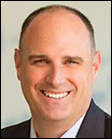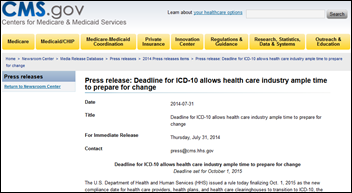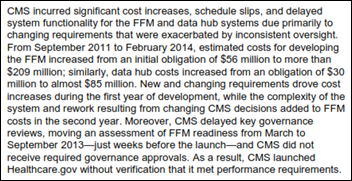Re: Dr Z. Great story, but whatever happened to professional courtesy???
News 8/1/14
A new CMS rule officially confirms October 1, 2015 as the new ICD-10 deadline. The announcement adds a bit of unintentional humor in saying the revised date “allows health care industry ample time to prepare for change.”
From The PACS Designer: “Re: Apple iTime. TPD’s sleuthing of US Patent Office new approvals has uncovered the iWatch patent. Apple iTime is the name given to patent # US 8,787,006 B2 for the wrist-worn device. Apple’s stock price has been rising since the patent was issued, probably some employees adding stock to their portfolios before any announcement from Apple.” It’s actually a three-year-old patent that was just approved, and like any good patent, is maddeningly vague to ensure covering as much intellectual property as possible. It mentions a GPS, heart rate monitor, accelerometer, and touch screen as options that are contained in the strap.

Siemens Products
By Quiet One
In response to Chester of Malvern’s post on “What a Cerner Acquisition of Siemens Health IT Would Look Like.”
As much as I criticize Cerner, at least they have an integrated system. Siemens Health Services’ systems might as well all be from different vendors. It seems like they deliberately made them difficult to integrate so they could sell more services. Or maybe that was the result of them laying off people in Malvern and outsourcing work to India.
I can’t imagine why someone would want to buy this set of assets other than for the customers and the data center. I doubt that Cerner would maintain the products, which is unfortunate since having lots of choices is good for all and Invision and MedSeries4 are good systems that got neglected due to the Soarian fiasco.
- "Soarian sites are happy with their financials, which are better than Cerner’s." I would seriously question this. Hardly anyone implemented Soarian Financials and they put even less effort into this product than they did Soarian Clinicals. It would probably be true to say Invision customers are happy with their financials, although that incidentally is the oldest part of Invision, based on IBM’s SHAS, and is batch oriented with sort of a CICS-based overlay so it’s not the most ideal product in my opinion.
- “Love the Soarian business process manager — the rules engine is quite impressive." If you’re impressed with their rules engine, which is a separate product on a separate box with its own implementation fees, you’ve obviously never worked with Epic, or for that matter, Cerner.
- "Siemens RIS…" Actually, this is one of their better products and is relatively stable. It has a pretty well designed Unix/DMQ/Sybase backend. Siemens is big in radiology because of their medical equipment business. The RIS product was moved out from under Siemens Health Services, so I wonder if it would be part of the sale.
- "Siemens Lab is a legacy system that customers love. KLAS rating is high even though they do not really manage pathology very well (lab is standalone)." This astonishes me more than anything and makes me question KLAS’s methods (Siemens does actively encourage customers to submit KLAS questionnaires). To say that it does not manage pathology very well is a big understatement. It does not have any pathology functionality at all, nor does it have blood bank functionality, or even instrument interfaces. It does offer a single outgoing and incoming instrument interface to connect to a broker like Data Innovations that you get to buy separately. It’s built on top of the Siemens RIS platform, but it seems like they gave up midway. So what does it do? Not much. In fact, for the administrative/setup functions, they use forms on a Microsoft Access MDE file linked to the Sybase back end.
- "Siemens Pharmacy and MAK works with Soarian – different platform, but functional." This is a DSM/Cache-based product built on top of their discontinued Unity system and has a lot of baggage from that. It actually is standalone and is often used by Invision and Soarian sites due to integration hurdles that Siemens imposes to prevent them from going with competing products. That said, integration between Siemens Pharmacy/MAK and Soarian is surprisingly difficult. You’ll also need to purchase the rules engine separately (again a separate box and separate implementation costs) and will probably need to purchase a third-party label printing system.
HIStalk Announcements and Requests
This week on HIStalk Practice: UNC-Chapel Hill researchers develop the FutureDocs physician shortage forecasting tool. Colden & Seymour ENT and Allergy, and Children’s Healthcare Massachusetts go live on the Wellport HIE. The American Academy of Family Physicians rebrands its Center for Health IT. The Children’s Health Alliance implements the Wellcentive Advance population health management platform. The Global Partnership for Telehealth conducts successful telemedicine consultations in Honduras. 23andMe secures new funding from the NIH. Take the HIStalk Practice reader survey. Thanks for reading.
This week on HIStalk Connect: Dr. Travis covers Benedict Evans’ most recent podcast, connecting the proliferation of smartphones with the inevitable scaling of mHealth use cases. Proteus Digital Health extends its Series G funding round to make room for more investors, closing the round at $172 million. Google announces a new health-focused X Labs project that aims to capture as much data as possible on human health, down to the genome and molecular level.
Acquisitions, Funding, Business, and Stock

MedAssets reports Q2 results: revenue up 2.7 percent, adjusted EPS $0.30 vs. $0.30, meeting revenue expectations and beating consensus earnings expectations of $0.29.

McKesson reports Q1 results: revenue up 37 percent, adjusted EPS $2.49 vs. $2.11, beating expectations on both. Meanwhile, an employee McKesson fired four months after the company’s last annual meeting in which the man asked CEO John Hammergren to improve employee wages and benefits was back at this this year’s meeting, hoping to persuade shareholders that Hammergren’s $292 million change-of-control golden parachute is unreasonable. The former employee and the union he works for were unsuccessful – shareholders vote down a proposal to reduce the amount, which McKesson’s board explain as “an important tool for motivating our executives in the face of a potential change in control transaction.”
From the McKesson earnings call:
- The company’s sale of its McKesson International Technology was reclassified from discontinued operations in 2014 to continuing operations in 2015, causing a charge of $34 million ($0.11 per share) to GAAP earnings.
- McKesson won’t rebid its UK workforce solutions business when it expires late next year.
- Technology Solutions revenue dropped 8 percent because of already-expected poor Horizon Clinical revenue, the divested foreign business, and “planned elimination of a product line.”
- John Hammergren is pleased with RelayHealth’s growth.
- He talked up CommonWell, which he says will be expanded and commercialized after the pilots are completed. He didn’t say what “commercialized” means.

From Merge Healthcare’s Q2 earnings call:
- The company says it, along with other enterprise imaging system vendors, is being hurt by indecision, mergers, and a preoccupation with ICD-10 and Meaningful Use Stage 2 among providers.
- Merge says it signed seven new iConnect customers in the quarter, iConnect Cloud Archive is growing rapidly, and Merge eClinical OS increased user count by 27 percent.
- The company expects hospital mergers to trigger new VNA and universal viewer sales.
- Merge is offering per-transaction contracts with no minimums.

In the Quintiles Q2 earnings call, CFO Kevin Gordon says he expects the acquired Encore Health Resources to contribute services revenue of $40 million. CEO Thomas Pike adds of the acquisition with regard to its pharma customers, “With our new acquisition of Encore, we also see this real flow of interest into the electronic health records and how our customers can really understand the practice of medicine taking place out in hospitals and in clinics associated with their drugs. I think the capabilities we’re assembling just give us unique insights for those customers.” Quintiles is a big pharma services vendor headquartered in Durham, NC with 29,000 employees and a $7 billion market cap.

CPSI announces Q2 results: revenue flat, EPS $0.81 vs. $0.77.

The Advisory Board Company reports Q1 results: revenue up 15 percent, adjusted EPS $0.30 vs. $0.31.

Vocera reports Q2 results: revenue down 9 percent, adjusted EPS –$0.16 vs. $0.01.
Sales
Healthcare Data Solutions will provide its US healthcare databases and business intelligence services to aPureBase, a Denmark-based life sciences data supplier.
Michigan Health Information Network selects DataMotion to provide Direct Secure Messaging services.

Capital Women’s Care (MD) enters into a 10-year agreement with NextGen Healthcare to provide RCM services for its 45 locations.
Bon Secours Health System (MD) will deploy Premier’s PremierConnect Enterprise data warehouse and business intelligence platform.
People

Vocera names Justin Spencer (Symmetricom, Inc.) as EVP/CFO.
Avery Cloud, CIO at New Hanover Regional Medical Center (NC), will leave the organization this week to take a position with an unnamed Houston employer.
Announcements and Implementations

Several Novant Health (NC) hospitals will go live on its $600 million Epic project this weekend. Novant says it hopes to avoid the Epic-related problems experienced by its Triad competitors Wake Forest Baptist Medical Center and Cone Health.
Navicure added 272 new accounts in Q2, a 76 percent jump over a year ago.
Geneia launches its Theon analytics platform.
Medical animation vendor Nucleus Medical Media joins the Greenway Marketplace.
Levi Ray & Shoup launches PageCenterX/Satellite to provide downtime reporting capabilities for system outages.
PMD launches its Observation Result interface to streamline cardiology test interpretations and charge capture.

Microsoft names Allscripts its “US Health Provider Partner of the Year.”
In Germany, the government will create an eHealth council to promote the exchange of digital healthcare information.
CHIME launches a new membership organization, the Association for Executives in Healthcare Information Security (AEHIS), as a professional organization for healthcare chief security officers. CSOs who are accepted by December 31, 2014 will be recognized as founding members and will receive a year of membership free.
Providence Health & Services partners with Patrick Soon-Shiong’s molecular medicine institute to buy a $10 million population-scale genomic sequencing system best known for breaking the under-$1,000 test barrier. Providence will use the genetic information to tailor cancer treatments to individual patients, processing the information on Soon-Shiong’s supercomputer array run by the NantOmics division of NantHealth.
Government and Politics

A GAO report concludes that Healthcare.gov has cost taxpayers $840 million so far and warns that continued CMS mismanagement, including sloppy contracting practices and poor oversight, will cause problems in the upcoming November open enrollment period. Accenture’s initial contract for $91 million to replace the fired CGI has already swelled to $175 million through June due to design revisions. CMS agreed with the report’s recommendations that they get their act together, which would have been nice a few hundred million dollars ago. Surely nobody other than the federal government could roll out a billion-dollar website. Maybe we taxpayers should develop our own Meaningful Use performance standards (with GAO’s help) and cut HHS’s budget for failing to meet them.

The Cover Oregon health insurance signs a $70,000 contract its former CIO Aaron Karjala, who resigned in March after the $134 million system’s failure. The state hopes he will help them build a case in their lawsuit against Oracle.
The CIA admits that its officers hacked into the computer network of the Senate Intelligence Committee, which oversees the agency.
Technology
George Takei gets a smartphone physical in Boston, although he seems more amused than impressed.

Dan Nigrin, MD, MS, SVP/CIO of Boston Children’s Hospital (MA), publishes an article in the just-released issue of The New England Journal of Medicine called “When ‘Hactivists’ Target Your Hospital.” It describes the orchestrated distributed denial of service (DDoS) attacks launched against the hospital by the hacker group Anonymous, which was upset about a child custody case. Data traffic jumped 40 times normal, although the hospital blunted nearly all of its impact by working with a DDoS defense vendor, which rerouted traffic to is filtering center and sent only legitimate web page requests through to the hospital. The group also tried direct network attacks and blasting phishing email hoping an ill-advised employee click would give it access. Dan urges hospitals to inventory their Internet-dependent systems and develop contingency plans if connectivity is lost, such as in their case where prescriptions could be created but not sent electronically to pharmacies. The hospital also temporarily shut down its email systems to figure out how to handle the phishing challenge and found quite a few undocumented internal processes that require email.
![]()
![]()
I’m trying not to swear at a writer’s incorrect summary of a predictably pro-EHR study from HIMSS Analytics (and published in two HIMSS-owned publications). It found that hospitals that are higher up the EMRAM ladder had better patient outcomes in some areas. For the zillionth time, correlation doesn’t equal causation. I have no doubt that hospitals that can run and afford Stage 6/7 EHR implementations can deliver better outcomes for specific diagnoses and procedures. However, that doesn’t mean the EHR contributed to the result just because it’s there. I bet there’s a similar correlation between patient outcomes and hospitals whose cafeteria features a sushi bar, but that doesn’t mean that adding sushi bar will improve heart attack survival rates. I would be more impressed with a vertical study that compares a single hospital’s results before and after EHR implementation. Don’t blame HIMSS Analytics since they were careful to use the word “association” – it’s writers who have never worked a day in healthcare or healthcare IT who are declaring authoritatively but inaccurately as they try to explain topics way over their heads.
A woman sues her plastic surgeon after finding before-and-after pictures of her face on his website with the label “cocaine nose.”
Weird News Andy calls this story a triple threat. A Michigan man dies when a medical problem causes him to crash his car into an abandoned house, which turned out to be full of swarming bees that kept rescuers from reaching him.
Sponsor Updates
- Six hundred Aprima users have signed up for the company’s user conference, which will be held August 8-10 in Dallas. ONC Deputy National Coordinator Jacob Reider, MD will deliver the keynote address.
- PerfectServe publishes a blog post called “TeamSTEPPS – Building a Support System for Safety.”
- CitiusTech is profiled in Forbes.
- Azam Husain discusses the importance of identity management for protecting patient health information on Caradigm’s blog.
- IHT2 shares a graph displaying the top 10 challenges faced by EHR users.
- Sagacious Consultants donates $10,000 to Wounded Warrior Project, Camp American Legion, the Legacy Fund, and the Aaron Grider Foundation in support of veterans.
- HIMSS Analytics Data reports that Imprivata OneSign is used by 51 percent of hospitals using McKesson’s Paragon or Horizon EMRs.
- Encore Health Resources CEO Dana Sellers discusses the company’s acquisition by a Fortune 500 company.
EPtalk by Dr. Jayne
I’m always on the lookout for any product or service that can make patients’ lives a little easier when they have to navigate the crazy healthcare world in which we live. I was excited to learn about CoPatient, which offers free audits of medical billing documents. The patient provides the bills and insurance information and they review and provide a no-charge report with a list of itemized costs and potential errors. From that point, patients can try to resolve the problem themselves, or CoPatient will handle the appeal for a fee.
They offer a “Negotiator” level, which is a flat 30 percent of the savings obtained. The “Guardian” level offers historical review or processing of regular medical bills through a monthly individual or family subscription. The Guardian level also includes use of their mobile bill pay app, but it’s full so you’ll have to go on a waiting list. I just finished fighting with my insurance company over an erroneous biopsy charge (I think I’d know if I had one). Based on my hourly salary and the time it took to resolve the issue, it would have been worth letting them handle it.

I had fun this morning doing a project for the urgent care where I moonlight. Although we use paper charts, many of the physicians work at other facilities where EHRs are in use. The lack of a way to electronically check medication prescriptions for patient safety and drug interactions has been a concern for several of them. I brought it up when I joined and offered to help find a system when they were ready.
We had a situation Monday night where I needed to urgently sign a Family and Medical Leave Act form that a patient brought by the office at the last minute. I’m on a belated birthday trip this week and had no access to a printer, let alone a fax machine. I signed it electronically using DocuSign (incidentally a new HIStalk Gold Sponsor) and emailed it back. Our managing partner was impressed that I knew to do that and emailed a few hours later asking me to look into eRx systems.
I knew of a couple of standalone systems but visited the Surescripts website to compare features. I was surprised by the sheer number of prescribing systems out there, whether freestanding or part of an EHR. I narrowed it down to a handful and started gathering information.
I’m planning to do a trial of the National ePrescribing Patient Safety Initiative product from Allscripts. The fact that it’s free is certainly a draw. It looked easy enough to register for the system and I’ll hopefully have time to do that in the next couple of days. I’m not scheduled to work at the urgent care until next week so we’ll have to see what I know by then.
Have you used a stand-along eRx system? Any advice? Email me.
Contacts
Mr. H, Lorre, Jennifer, Dr. Jayne, Dr. Gregg, Lt. Dan, Dr. Travis.
More news: HIStalk Practice, HIStalk Connect.
Get HIStalk updates.
Contact us online.










No inside insight into a Cerner/Siemens deal, but I see three big advantages for Cerner in a potential acquisition. 1) Acquisition of client base. Likely would encourage a move to Cerner. 2) Siemens medical device business. 3) Talent acquisition. In particular, the revenue cycle knowledge base would be very beneficial in the advancement of their new financials system.
Real question is will these provide a big enough benefit to actual make the challenges of supporting Siemens systems and headaches of merging two very big, very different companies? Additionally, you could see some bleeding of clients and employees leading up to any sale, so Cerner may be able to get some of the benefits without spending the money.
RE: A GAO report concludes that Healthcare.gov has cost taxpayers $840 million so far and warns that continued CMS mismanagement, including sloppy contracting practices and poor oversight…
Glad that we have CMS leading the way with ONC.
They have terms for this in the military and it’s tragic that the DoD or the VA in any way take advice from ONC.
CMS and ONC are screwing up healthcare IT in as spectacular a manner as CMS did healthcare.gov.
And, who would have guessed that an Accenture government contract wouldn’t have quadrupled in the first year?
Re: Encore Health Resources CEO Dana Sellers discusses the company’s acquisition by a Fortune 500 company.
Does it ever go well for a mid-size healthcare IT firm that is purchased by a Fortune 500 company? Maybe we should ask the folks who used to work for FCG, Vitalize, maxIT, Healthlink, etc.
Thank you, Quiet One, for a more realistic description of the nightmare that is Siemens. I can only guess that Chester has never actually attempted to use or maintain a Siemens HIT product. The best case scenario (the one that I’m desperately hoping for) would be for Cerner to take over and move everyone onto their platform. It’s the only humane thing to do.
McKesson and Cerner will be trying to commercialize Common Well and will hold information exchange hostage to their products.
Force them to be open and support direct exchange EHR to EHR like Epic and the other members of HealtheWay.
Mr. H – would be cool to get a joint interview with Cerner and McKesson to disclose their plans to “commercialize” CommonWell.
From your post:
==
John Hammergren is pleased with RelayHealth’s growth.
He talked up CommonWell, which he says will be expanded and commercialized after the pilots are completed. He didn’t say what “commercialized” means.
==
My guess is that they’re going to sell data in a big way and if they get established, sign other vendors up to get some additional cash by cutting them in for a percent if they wire their EMRs to CommonWell.
Deborah Peel’s going to have fun with this!
Oh, also, when is Cerner going to swear off it’s closed and proprietary ways? They have a proprietary and expensive database (which they should swap out for MySQL) and a ridiculously custom programming language (CCL = Cerner Command Language).
Didn’t writing your own programming language go out of fad a while back?